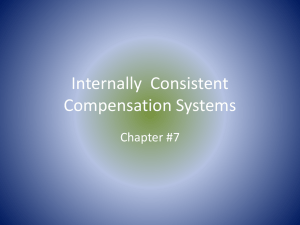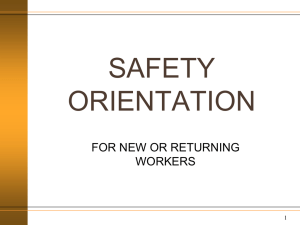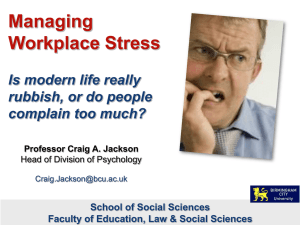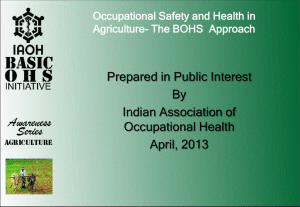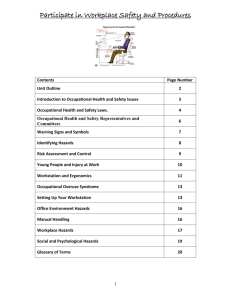OCCUPATIONAL HEALTH NURSING
advertisement
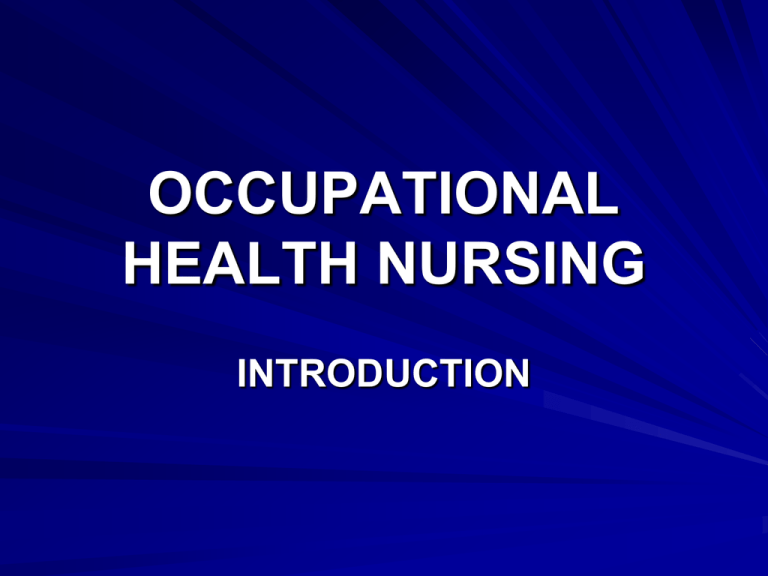
OCCUPATIONAL HEALTH NURSING INTRODUCTION WHAT IS WORK & HEALTH WORK / OCCUPATION An essential human activity that occupy a considerable part of a person’s waking hours Can be stimulating & rewarding Can contribute to stress HEALTH NOT merely the absence of disease BUT a state of complete physical, mental, social and spiritual well-being (Wellers, 2000) What is Occupational Health? WHO defined Occupational Health as; ‘the promotion and maintenance of the highest degree of physical, mental and social well-being of workers in all occupations’ (Harrington & Gill,1992) Cont...... Concerned with two-way relationship of WORK and HEALTH Related to the effects of working condition and/or environment on health of worker – influence on ability to perform tasks in the workplace Prevention is better than cure –ensuring work & working condition DO NOT affect the health of people What is Occupational Health Nursing? Application of nursing principles in conserving the health of workers at the workplace. Based on principles of recognition, prevention and treatment of illness, injuries. Formally known as ‘Industrial Nursing’ Pioneers of OHN Services Florence Nightingle (UK 1820) Phillipa Flowerday (UK 1878) Betty Moulder (US 1888) Ada Mayo Stewart (US 1895) Aims of OHN Promotion and maintenance of the highest degree of physical,mental and social well-being of workers in all occupations ; - by preventing- departures from health caused by their working conditions, - protecting the workers in their employment from risks resulting from factors adverse to health - and adaptation of work to the workers and workers to their jobs Objectives Maintenance and promotion of workers’ health and working capacity(Health monitoring) Improvement of working environment and work to become conducive to safety and health(Worksite visits) Development of work organisations and working cultures in a direction, which supports health and safety at work(Health Education ) Relevant Legislations on Occupational Health & Safety • Employment Order 2009( pre-employment medical examinations ,first aid & medical treatment, worker housing ,night work ,child labour)-Previously Brunei Labour Laws 1954 • Workmen Compensation Act 1957 (workplace accidents & occupational diseases) • Workplace Safety & Health Order 2009 The Scope of OHN practice 1. Prevention of occupational injuries 2. Prevention of occupational illness 3. Reducing work place hazards 4. Promotion of worker’s health 5. Restoration of worker’s health (maintenance of worker’s health) Occupational injuries such as a cut, fracture, sprain, amputation, etc, that may results from a single instantaneous exposure or incident in the work department or during the course of work. Occupational illness any abnormal condition or disorder, other than one resulting from an occupational injury caused by exposure to environmental factors associated with employment. It can be acute or chronic illnesses, following exposure to the hazards through inhalation, absorption, ingestion, or direct contact. Work and Health Exposure to health hazards in the workplace may cause adverse health effects Disease development depends on; host factors, non-occupational exposure (lifestyles & hobbies), environmental factors, inherent properties of the agent, exposure level, exposure length & other workplace stressors. Factors influencing our Health Genes • Determine who you are • Likelihood of contracting disease Environment Health •Workplace • Leisure • Domestic/living Environment Lifestyles • Smoking • Diet • Alcohol • Stress • Exercise Cause and effects Lung cancer Cause is hard to see Fume fevers Stress Leukaemia Dermatitis Musculo-skeletal disorders Solvent effects NIHL Welder’s Flash Cause is easy to see Mesothelioma Accidents Minutes Days Months Years Decades Basic Principles of Disease Prevention Higher level of surveillance NURSING INTERVENTIONS High degree of hazard TERTIARY PREVENTION System of enquiry • Treatment / Referral • Lung Function Test • Personal Protective Equipment • Health Screening • Early detection SECONDARY PREVENTION • Health education Lower level of surveillance Limited evidence of hazard and exposure PRIMARY PREVENTION • Base-line health assessment • Elimination of substances Workplace Hazards Physical hazards Chemical hazards Biological hazards Mechanical hazards Psychosocial hazards Ergonomic Hazards Safety Workplace Health & Safety Who are legally responsible for identifying and correcting health and safety hazards? Authorised personnels Employers Contractors Owners Workers Supervisors Self-employers persons Suppliers Protected workers fundamental rights To know about hazards in the workplace, how to identify them and how to protect themselves To participate in health and safety decisions through management’s consultation with occupational health committees and workers To refuse unusually dangerous work According to The Occupational Health and Safety Act - OSHA (1993), “…..everyone in the workplace is required to work together to identify and control health and safety hazards” Who are the Occupational Health Team? Occupational health physician Occupational health nurse Occupational health epidemiologist Occupational hygienist Industrial toxicologist Industrial psychologist Ergonomist Occupational therapist Physiotherapist Health educator Safety engineer THANK YOU ! Ergonomist design the workplace and the job to fit the worker. It deals with designing and changing the workplace to ensure employees are not injured or made unusually uncomfortable when working. Ergonomics Lifting and handling loads Work that involves standing for long periods of time, antifatigue mats and footrests Situations where it is appropriate for workers to be permitted to sit while working, seating requirements and footrest Musculoskeletal injuries which include muscle injuries or disorders of tendons, ligaments, nerves, joints, bones, etc Epidemiologist studies the incidence and distribution of diseases in large populations, and the conditions influencing the spread and severity of disease. Hygienist responsible for recognizing, evaluating and controlling health hazards in the workplace. to do this an occupational hygienist will examine the work environment and work activities.
